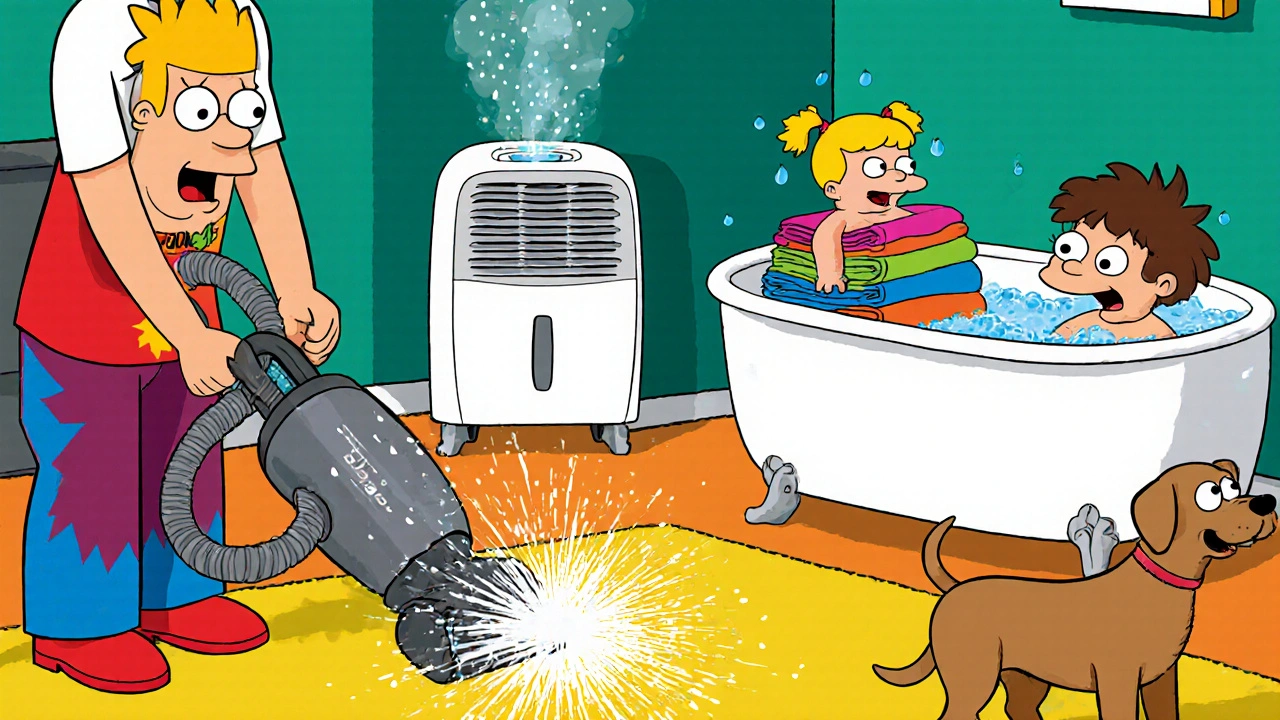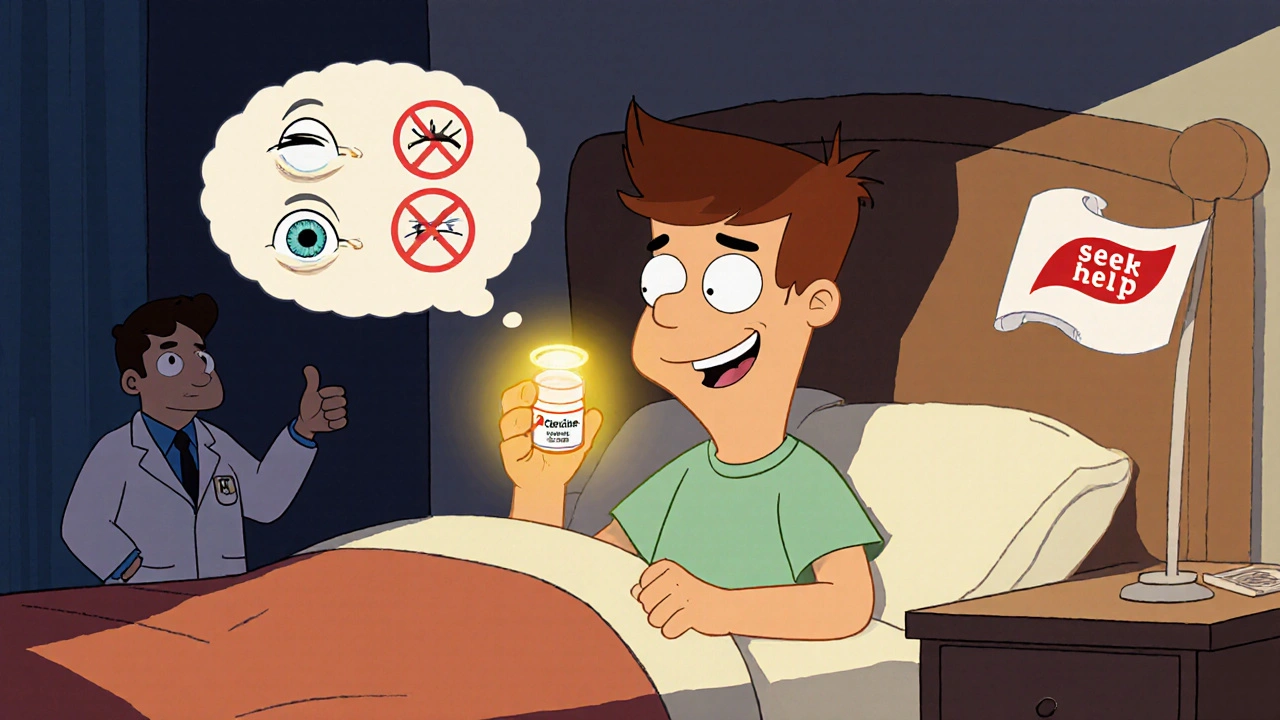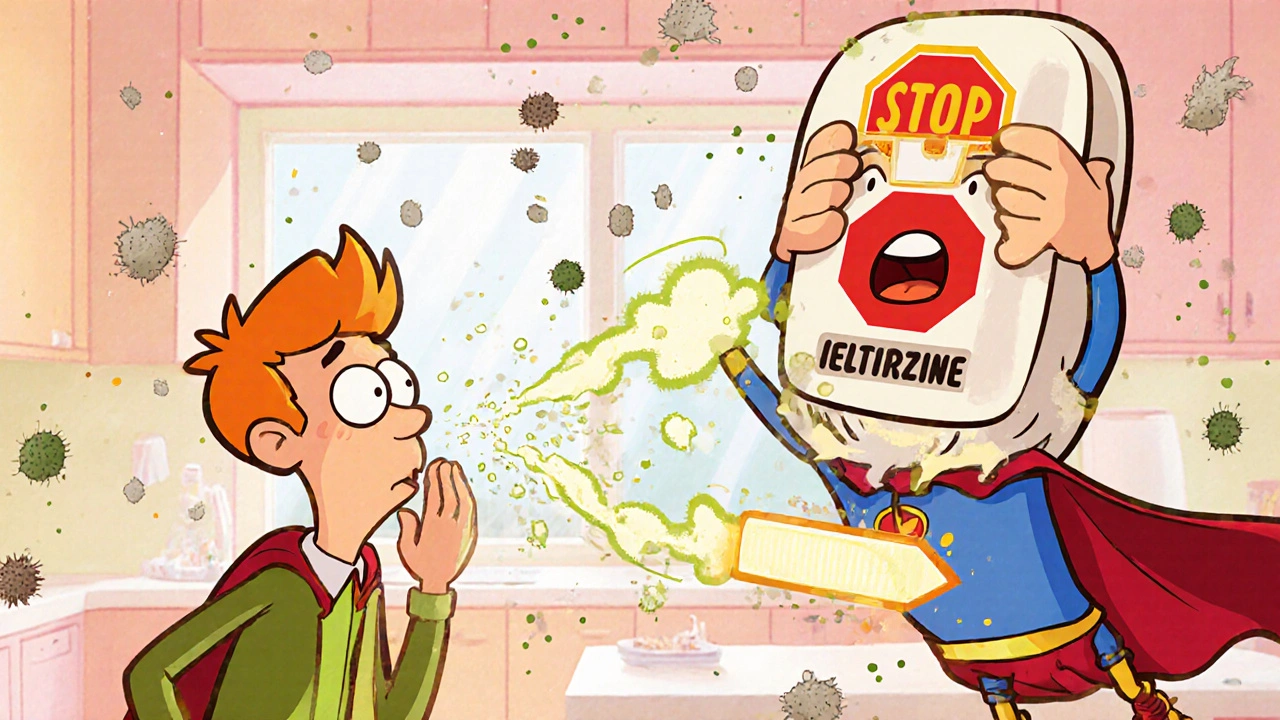Quick Takeaways
- Cetirizine blocks histamine, easing sneezing, itching, and watery eyes caused by indoor allergens.
- Typical adult dose is 10 mg once daily; kids 5 mg (2-5 years) or 10 mg (6-11 years) after doctor approval.
- It works faster than older antihistamines and causes less drowsiness for most people.
- Combine the pill with simple home steps-regular cleaning, HEPA filters, and humidity control-for best results.
- Seek medical help if symptoms persist after a week of consistent use or if you experience severe side effects.
What is Cetirizine a second‑generation antihistamine that blocks the action of histamine, the chemical your body releases during an allergic reaction?
When you breathe in dust, pet dander, or mold spores, your immune system may overreact. It releases Histamine a compound that triggers allergy symptoms like itching, sneezing, and runny nose. Cetirizine binds to the same receptors histamine wants to use, effectively putting a stop‑sign in front of the allergy cascade.
Because it’s a second‑generation drug, it crosses the blood‑brain barrier much less than older antihistamines. That’s why most adults stay awake and alert while taking it.
How does cetirizine help with Indoor allergies allergic reactions triggered by allergens found inside homes such as dust mites, pet dander, and mold spores?
Indoor allergens are usually constant-dust settles on surfaces, pets shed daily, and mold thrives in damp corners. When you inhale them, the body launches an immediate response. By blocking histamine, cetirizine reduces the three biggest complaints:
- Sneezing and nasal congestion
- Itchy, watery eyes
- Itchy skin or throat
People often notice relief within 30‑60 minutes, and the effect can last up to 24 hours, making once‑daily dosing practical.
Typical Dosage and Safety Tips
Getting the dose right is key. Below is a quick reference (always confirm with your pharmacist or doctor):
| Age Group | Standard Dose | Maximum Daily Dose |
|---|---|---|
| 2-5 years | 2.5 mg once daily | 5 mg |
| 6-11 years | 5 mg once daily | 10 mg |
| 12 years + (adults) | 10 mg once daily | 10 mg |
Take the tablet with water, preferably with food if you notice a mild stomach upset. If you’re pregnant, nursing, or on other meds (especially sedatives or alcohol), talk to a healthcare professional first.
Common side effects are mild: a dry mouth, headache, or slight drowsiness (affecting only ~10 % of users). If you feel intense sleepiness, try taking it at night.
How Does Cetirizine Compare to Other Antihistamines?
Not all antihistamines are created equal. Below is a side‑by‑side look at the most popular over‑the‑counter options.
| Drug | Generation | Typical Adult Dose | Drowsiness Rating (1‑5) | Onset of Relief |
|---|---|---|---|---|
| Cetirizine second‑generation antihistamine | 2nd | 10 mg daily | 1-2 | 30‑60 min |
| Loratadine second‑generation antihistamine | 2nd | 10 mg daily | 1 | 40‑60 min |
| Fexofenadine second‑generation antihistamine | 2nd | 60 mg twice daily | 1 | 1‑2 hrs |
All three are non‑sedating for most people, but cetirizine often feels a bit stronger on the symptom‑relief front, especially for nasal congestion.

Practical Home Strategies to Cut Indoor Allergen Load
Medication works best when the environment isn’t constantly feeding the allergy engine. Here are actions you can start today:
- Vacuum with a HEPA‑filter cleaner twice a week. Regular vacuums can push dust back into the air.
- Dust mites microscopic creatures that thrive in bedding and upholstery love humidity. Keep indoor humidity below 50 % using a dehumidifier.
- Wash sheets, pillowcases, and blankets in hot water (≥ 130°F) weekly to kill mites.
- If you have cats or dogs, **bathe** them weekly and keep them off beds and upholstered chairs.
- Use a Mold spores fungal particles that grow in damp places and trigger allergies‑free zones by fixing leaks promptly and wiping bathroom tiles after showers.
- Consider an Air purifier device that filters airborne particles, including allergens with a true HEPA rating for rooms where you spend most of your time.
These steps don’t require a big budget, but they dramatically reduce the amount of allergen particles that cetirizine has to fight.
When to Call a Healthcare Professional
Even the best antihistamine can’t solve everything. Keep an eye on these red flags:
- Symptoms linger beyond a week despite daily cetirizine use.
- Severe headache, swelling of the face or throat, or difficulty breathing-possible signs of an allergic reaction that needs urgent care.
- Persistent drowsiness or unusual heart palpitations.
- You're pregnant, nursing, or already taking prescription meds like antidepressants, blood pressure drugs, or asthma inhalers.
A doctor may suggest a short course of a nasal corticosteroid, such as Nasal corticosteroid spray that reduces inflammation in the nasal passages, or a leukotriene blocker like montelukast if asthma is also present.
Putting It All Together
Managing indoor allergies isn’t a one‑size‑fits‑all prescription. cetirizine gives you fast, reliable symptom relief, but it works best when you shrink the allergen source at home and stay aware of how your body reacts. By combining the right dose, a clean indoor environment, and a clear line of communication with your healthcare provider, you’ll breathe easier and enjoy daily life without constant sneezing fits.
Can I take cetirizine with other allergy medicines?
Yes, you can combine cetirizine with a nasal corticosteroid spray or a saline rinse. However, stacking two oral antihistamines (like loratadine) isn’t recommended because it won’t boost relief and may increase side effects.

Is cetirizine safe for children?
Yes, for kids aged 2‑11 the dose is lower (2.5‑5 mg). Always follow the pediatric label or a doctor’s guidance, especially if the child has liver or kidney issues.
Will cetirizine make me sleepy?
Most people experience little to no drowsiness. About 10 % may feel a little sleepy, especially at the start of treatment. If it bothers you, take the dose at night.
How long does cetirizine stay in my system?
The drug’s half‑life is roughly 8‑10 hours, so a single dose can cover a full day. It may take 2‑3 days of regular dosing to reach steady‑state levels.
Can I use cetirizine if I have asthma?
Yes, cetirizine can help asthma patients who also suffer from allergic rhinitis. It won’t replace a rescue inhaler, but it can lower overall airway irritation caused by allergens.

Diana Jones
When you’re navigating histamine pathways, think of cetirizine as the high‑throughput API that gates receptor activity. Its second‑generation pharmacokinetics let you sidestep the classic sedative crash that older antihistamines love to hand out. Sure, because who doesn’t want a drug that masquerades as a superhero while still letting you binge‑watch without dozing off. Pair it with diligent cleaning and you’ve built a multi‑layered defense against indoor allergens.
Abbey Travis
Got a dusty bedroom? Start by swapping your regular vacuum for a HEPA model and run it twice a week – that alone can cut airborne particles by up to 60 %. Throw in a quick weekly wash of bedding at 130 °F and you’re already taking the sting out of dust‑mite exposure. The article’s tips are solid, but remember to keep humidity under 50 % with a dehumidifier to starve mites of moisture. Consistency is key, so set a reminder and stick with it.
ahmed ali
Okay, let me break this down because the whole “just pop a pill and you’re done” narrative is honestly oversimplified and kinda misleading. First off, cetirizine’s half‑life of roughly 8‑10 hours means you’re not getting a 24‑hour vacuum that sucks up every single allergen particle, you’re just moderating the histamine response that your immune system throws at you. Second, the idea that it’s completely non‑sedating is a myth that the marketing folks love to push – about ten percent of users will feel a little drowsy, especially if they’re also pulling all‑night study sessions or late‑night gaming marathons. Third, the dose for kids isn’t just “half an adult pill”; the pediatric formulation is calibrated to body weight and metabolic rate, so giving a 5‑year‑old a full 10 mg tablet can actually overload their liver enzymes and cause unnecessary side effects. Fourth, combining cetirizine with alcohol or other CNS depressants can amplify that sleepy feeling even though the drug itself doesn’t cross the blood‑brain barrier as much as first‑generation antihistamines. Fifth, environmental controls are not an optional add‑on – they’re the core of any real‑world allergy management plan, because no pill can neutralize a room that’s constantly re‑seeded with dust mite feces. Sixth, the HEPA filter recommendation is spot on, but you’ve also gotta change the filter regularly; a clogged filter just circulates the same particles back into the air. Seventh, humidity control is crucial – mold loves damp spots, and even a few percent over 50 % can turn a harmless wall into a spore factory. Eighth, if you’re using a nasal corticosteroid in conjunction, make sure you’re not double‑dosing on steroids – that can lead to nasal irritation or even epistaxis in rare cases. Ninth, the article briefly mentions drug interactions, but you should also watch out for certain antibiotics like erythromycin that can increase cetirizine plasma levels. Tenth, while the “once‑daily” dosing sounds convenient, taking it at night might be better for those who notice that slight bedtime drowsiness, which can actually improve sleep quality for some sufferers. Eleventh, if you have asthma, cetirizine can reduce upper‑airway irritation but it won’t replace your rescue inhaler, so keep that on hand. Twelfth, people often forget to mention that the pill can be taken with or without food, but if you have a sensitive stomach, a light snack can mitigate that mild upset. Thirteenth, the “no need to stack antihistamines” rule is absolute – mixing two oral antihistamines just piles on side effects without adding benefit. Fourteenth, if you ever notice persistent headache, rapid heart rate, or swelling of the face, that’s a red flag and you need to seek care immediately. Fifteenth, the best way to gauge effectiveness is to track your symptoms over a week; if there’s no improvement, you might need a different class of medication or a higher‑dose prescription. Finally, remember that adherence is everything – skipping doses turns the whole regimen into a half‑baked experiment that won’t give you the relief you’re looking for.
Deanna Williamson
The data presented aligns with current pharmacodynamic profiles, yet the article omits a quantitative comparison of cetirizine’s Ki values versus loratadine. Without that metric, readers can’t fully appreciate the marginal superiority in receptor affinity that might translate to clinical benefit. Additionally, the discussion of side‑effect incidence lacks confidence intervals, which are essential for evaluating the true risk differentials.
Carolyn Cameron
In summation, the discourse concerning cetirizine elucidates a commendable synthesis of pharmacotherapeutic efficacy and pragmatic domestic interventions. Nonetheless, a more erudite exposition could have incorporated a rigorous meta‑analytic appraisal of comparative antihistaminic outcomes, thereby augmenting the scholarly gravitas of the treatise.
Ben Durham
To add to the preceding point, the pharmacokinetic profile of cetirizine is characterized by minimal hepatic metabolism, which reduces the likelihood of cytochrome‑P450 mediated interactions. This attribute makes it a suitable candidate for patients on polypharmacy regimens, provided renal function is monitored.
Chris L
Great points raised so far! Just a reminder that staying consistent with the cleaning schedule can amplify the medication’s effect, turning a good day into a great one. Keep the momentum, and you’ll notice the sneezing fits taper off faster than you expect.
Charlene Gabriel
Building on what has already been shared, it’s worth emphasizing that creating an allergy‑friendly environment is a multi‑step process that benefits from a community mindset. Start by enlisting every household member in the weekly vacuuming ritual, making it a shared responsibility rather than a solitary chore. Next, consider rotating the locations of your dehumidifier to address hidden moisture pockets that might otherwise be overlooked. Don’t underestimate the power of a simple saline nasal rinse each morning; it can physically flush out residual allergens that the medication alone may not clear. Additionally, for families with children, turning the cleaning tasks into a game-like “who can find the most dust bunnies” – can foster engagement while simultaneously reducing allergen loads. Lastly, keep a symptom diary for at least ten days; this data will provide tangible feedback on how well the combined strategy of medication and home maintenance is performing, allowing for timely adjustments if needed.
Leah Ackerson
In the grand tapestry of human suffering, allergic sneezing is but a fleeting inconvenience, yet we treat it with the gravity of a existential crisis 😏. The article’s checklist reads like a novice’s wish list; true mastery demands a holistic approach that transcends mere pills and vacuum cleaners. Remember, the mind can amplify or diminish the perception of itchiness, so cultivate a stoic attitude while you combat the microscopic invaders.
Gary Campbell
What most people don’t realize is that the push for over‑the‑counter antihistamines is part of a larger agenda to keep us dependent on synthetic solutions rather than encouraging true indoor air quality reforms. The chemical industry funds many of these “educational” campaigns, ensuring that consumers reach for the next tablet instead of demanding stricter building codes on ventilation.
renee granados
Stop buying cheap meds and start fixing the real problem – your house is a dust factory.
Stephen Lenzovich
America’s pioneering spirit demands we reclaim clean air without bowing to pharmaceutical complacency.
abidemi adekitan
Picture your living space as a vibrant garden where each breath is a fresh blossom; by sweeping away the invisible weeds of dust and mold, you let the natural fragrance of health blossom unimpeded.
Barbara Ventura
Wow!!! This is a solid overview; the tips are practical!!! Keep it up!!!